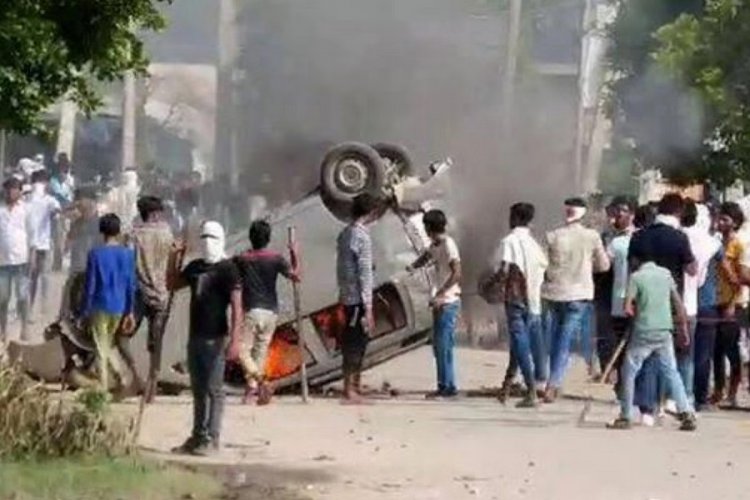Haryana: Communal Violence; a Mojrity BIAS

The communal violence in the district of Nuh in Haryana, broke out during a religious procession that was organised by the VHP (Vishwa Hindu Parishad) annually. The VHP is a right-wing Hindu organisation based on Hindu nationalism.
The violence has left at least five dead, amid incidents of stone-throwing, burning of vehicles and torching of a place of worship by mobs on a rampage, with tensions spreading to surrounding districts, including Gurgaon. In the backdrop of the flare-up in Nuh, is the abduction and murder of two men in February by cow vigilantes in Bhiwani, Haryana — the main murder accused, who belongs to the Bajrang Dal and is still at large, reportedly played a role in stoking tensions ahead of the religious procession.
The onus is on politicians and the state, writes The Indian Express. “Not all of the Supreme Court’s laments or anguished strictures against hate speech can make a difference if there are political incentives for sharpening prejudice and polarisation on the ground…..”
Governance gaps
The Hindustan Times writes “if the fringes of a Capital get singed by communal clashes a month before it is hosting 20 heads of State, hard questions need to be asked of the Haryana administration…” Obviously there are serious governance gaps.
The fact that armed processionists managed to enter a communally sensitive area, a locality whose residents predominantly belong to the Muslim community, according to The Stateman “underlines serious lapses on the part of the authorities. It’s obvious that the standard operating procedure (SOP) for such situations was given the go-by, which apparently made it easier for the waiting mob to launch an all-out attack.
“……With Bajrang Dal’s cow vigilante Monu Manesar, an accused in a lynching case, mobilising people to throng temples in Mewat, trouble was just around the corner……”
Citizens and Lawyers Initiative: Earlier this year, the Citizens and Lawyers Initiative, a civil society group, had brought out a report titled ‘Routes of Wrath — Weaponising Religious Processions’. It presented a case-by-case analysis of the genesis and spread of communal riots and how processions taken out on religious occasions had become a platform for inciting hatred and violence.
TV news shy to identify victims when they are Muslim
Stating that is this our idea of India, Shailaja Bajpai (Readers’ Editor & Editorial Advisor, Media Columnist, ThePrint) writ4es "It took the Tuesday morning newspapers – and social media Monday evening — to highlight one crucial fact that news channels had missed or chosen to ignore: three of the four men Chetan Singh, the RPF soldier) killed in the train were Muslim.
“Another (deliberate?) omission by TV news was revealed in The Indian Express online report Monday—it told us what the constable had ‘purportedly’’ said during the killing spree, recorded on a video by a passenger. It quoted the part that is clearly audible, concerning ‘Pakistan…’ and an exhortation to vote for ‘Modi aur Yogi…’
"Why news channels missed these aspects is a question they ought to answer, considering that in the Nuh communal clashes, it is now naming some of the victims – Republic TV shared the autopsy report of Home Guards ‘Neeraj’ and ‘Gursewak’.”
It is apparent that the media will not give “us a pretty good idea of India…”
Exodus of Muslims: Recent reports from Gurugram suggest that the violence of the past few days has abated. It is however unclear, writes Sanjay Srivastava (British Academy Global Professor, Department of Anthropology and Sociology, SOAS University of London and author of Entangled Urbanism: Slum, Gated Community and Shopping Mall in Delhi and Gurgaon) “how many Muslim families of working-class backgrounds — faced with implied and actual violence — have returned to their villages…..”
Embarrassing for PM’s subtle Hindutva
In the circumstance, writes Parsa Venkateshwar Rao Jr (Delhi-based commentator and analyst) “the BJP’s dilemma is quite acute. On the one hand, Prime Minister Narendra Modi asks the party legislators to go to Muslim homes and get a ‘rakhi’ tied by Muslim women to mark the ‘Rakshabandhan’ (where women tie a string on the wrists of their brothers) festival, and on the other hand the VHP and the Bajrang Dal are out on the streets to provoke the Muslims. Once the provocation is triggered and the cycle of violence begins, the provocateurs argue that the violence was triggered by the other side. So, some of the media are focusing on why Haryana’s Nuh is the bad place it is, and how dangerous the presence of Tabligh-e-Jamaat working on the ground is, and how illegal Rohingyas are finding shelter in the place. The VHP and Bajrang Dal get off the hook……..”
This is “an embarrassment for Prime Minister Narendra Modi, who has been playing down the right-wing elements of his party’s ideology in the run-up to the G-20 summit in the first week of September, and he doesn’t want untoward incidents like the ones in Manipur and in Haryana, both involving the minority communities, Christian Kukis in Manipur and Muslims in Haryana……The VHP and Bajrang Dal have upset the Mr Modi’s subtle Hindutva strategy of harping less on Muslims and Christians while implementing the majoritarian ideology.
















